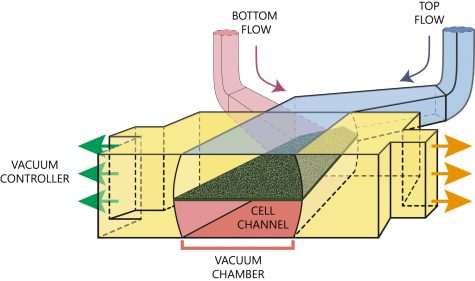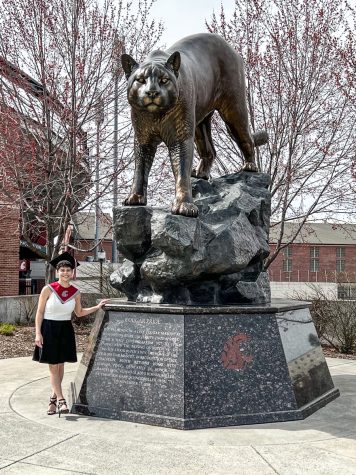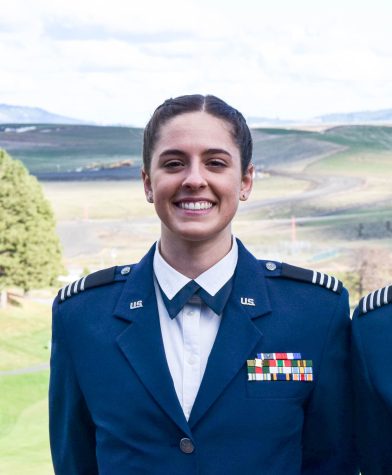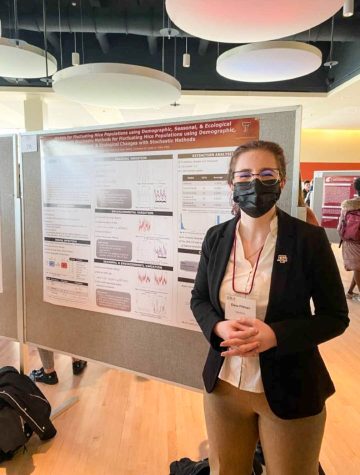Students designed eye tracker testing rig
Eye tracking technology helps people with neurodegenerative diseases communicate
An eye tracker can rotate and follow a person’s eyes to monitor where they are looking. The technology allows a person’s eyes to control a mouse on a computer screen.
January 28, 2021
WSU engineering students are testing eye-tracking technology to improve the quality of life for people who have neurodegenerative diseases and no alternative way to communicate.
Last semester, the team was building a testing rig to evaluate eye trackers for their Capstone project, said Jon Campbell, project mentor and senior research software development engineer at Microsoft Research. An eye tracker is a camera that recognizes a face and follows a person’s eyes to monitor where they are looking.
Eye trackers are linked to a communication system or computer, but are not compatible with everyone, said Leif Harfst, WSU alumnus and former engineering student who worked on the project. For example, someone’s posture, skin color, eye color or movement characteristics may confuse the technology.
In order for someone to qualify for eye-tracking technology, they must not be able to speak, so it is difficult to get feedback from them, Campbell said.
“[Eye tracking technology] is one of their only forms of communication because they can still move their eyes,” Harfst said.
The WSU team is working with remote eye trackers, which mount to the bottom of computer screens and use infrared light to recognize eyes, Harfst said. The technology allows a person’s eyes to control the mouse on the computer screen.
The students used an artificial face with eyes that could rotate and replicate the movement of a person’s face, he said. However, using artificial eyes posed a challenge.
Other teams who worked on this project from previous semesters were not able to find a solution that closely replicated human eyes, Harfst said. This past semester, the team discovered anatomically correct eye technology, which is used to train eye doctors.
The eyes are filled with water and have reflective properties similar to human eyes, he said.
Eye trackers send infrared light and perceive a reflection off of human eyes, Harfst said. Anatomically correct eyes have structure and depth, which allows them to reflect the infrared light.
The technology the student group created is targeted toward research institutes and eye tracker manufacturers, Campbell said.
The team has been working with Microsoft Research and WSU’s Steve Gleason Institute for Neuroscience because they want to create a database with the distinct capabilities of eye trackers, including models from different manufacturers, Campbell said.
This semester, the new WSU team will build two copies of the eye tracker testing rig to send to Microsoft, said Chuck Pezeshki, adviser to the senior Capstone project. The company will then work with eye tracker manufacturers to create improvements in the devices.
“The goal with the testing rig that [Microsoft] had the students build is to try and get a better, clear understanding of how these eye trackers actually work in real life,” Campbell said.
Eye-tracking technology has been around for decades, he said. However, this is the first experiment that has been done with eye tracker testing rigs.
Campbell said his team at Microsoft Research focuses on how eye tracking technologies can help people with the neurodegenerative disease amyotrophic lateral sclerosis, better known as ALS.
For the last three years, the team has focused on creating eye tracking testing rigs, he said.
Campbell said he takes pride in working to improve the quality of life for people who cannot help themselves.
“I don’t have medical skills, I don’t have genomic skills, so I can’t help find a cure,” he said. “What I can do is leverage my technical skills to help where I can.”
Harfst said Campbell presented the idea to the Capstone class, making it evident there is a need for this type of research.
People who have neurodegenerative diseases have trouble finding a suitable eye tracker to fit their needs. Harfst said he wanted to improve the quality of life for people with neurodegenerative diseases, so they would be able to communicate their wants and needs with their family and friends.
Next semester’s team will focus on refining the hardware design and come up with additional tests to run on the eye trackers, Harfst said. They will focus on testing different models and types of eye trackers.
“[Our group] got the bulk of the dirty work out of the way: getting a working system that the next team can improve upon,” he said.





















